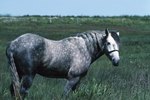In horses, a blue colored eye is referred to as a wall eye. Horses may have two blue eyes, or one blue and one brown eye. The blue color is created by a lack of pigmentation in the iris. The genetics that cause a horse to have a wall eye are not well understood, but many breeds, including quarter horses, Thoroughbreds, Arabians and Tennessee walkers, all have some registered horses with blue eyes.
Wall-Eyed Horses
Horses with the double dilute creme genes, or cremellos, have two blue eyes. Champagne-colored horses also have blue eyes. This dominant gene causes the same dilution of pigment as the dilute genes that cause some horses to have cremello-colored bodies.
Horses with coats other than cremello may have blue eyes. They are most common in horses with white spots, or overos. Blue eyes are especially common in overos, along with a white blaze or other white on the head. Not all overo horses have blue eyes, though. Breeders are currently unable to predict whether a horse will have blue eyes.
Wall Eye Health Concerns
Horses with blue eyes are more likely to develop squamous cell carcinoma than horses with blue eyes. This is a type of skin cancer that these horses are more prone to due to the lack of pigmentation both in the eyes and surrounding skin. Blue-eyed horses are not at greater risk for any other health condition or vision problem than a horse with brown eyes.
Conditions That Cause Blue Eyes
Some health conditions in horses may cause an eye to appear white or cloudy. This is not the same as a wall eye, or blue eye, that a horse is born with.
Two common eye conditions that cause the eye to look cloudy and lose brown pigmentation are inflammation of the cornea and cataracts. Inflammation of the cornea may be caused by increased pressure with in the eye or by a corneal ulcer, commonly caused by an eye trauma. Cataracts cause white cloudy coloring on the lens inside the eye rather than on the surface as with corneal inflammation. Some horses are born with cataracts; others get them due to illness or injury.
Warnings
If your horse's eyes become white or cloudy, or if they lose pigmentation, contact your veterinarian to determine the cause and treat the condition.
Writer Bio
Maureen Malone started writing in 2008. She writes articles for business promotion and informational articles on various websites. Malone has a Bachelor of Science in technical management with an emphasis in biology from DeVry University.




